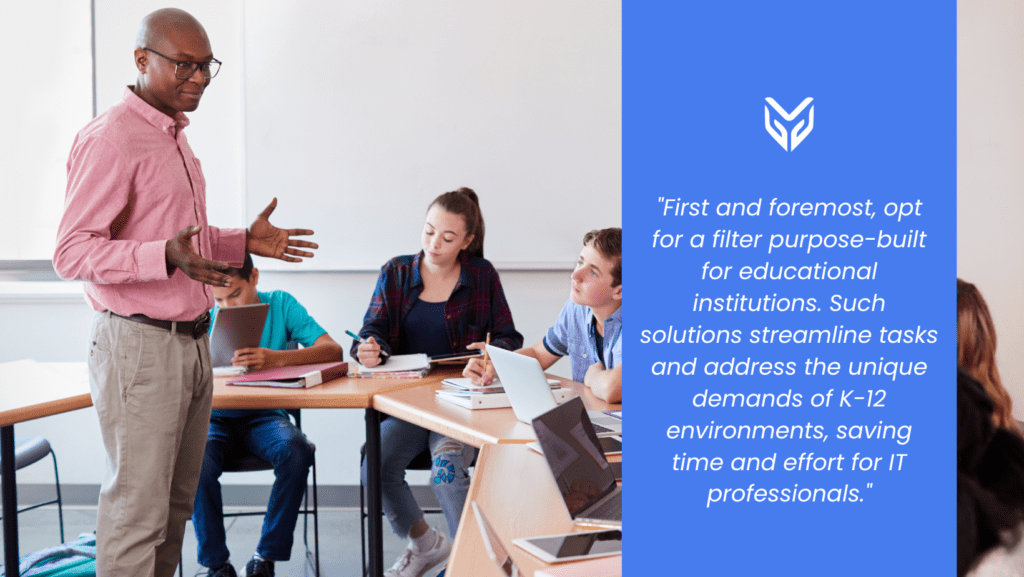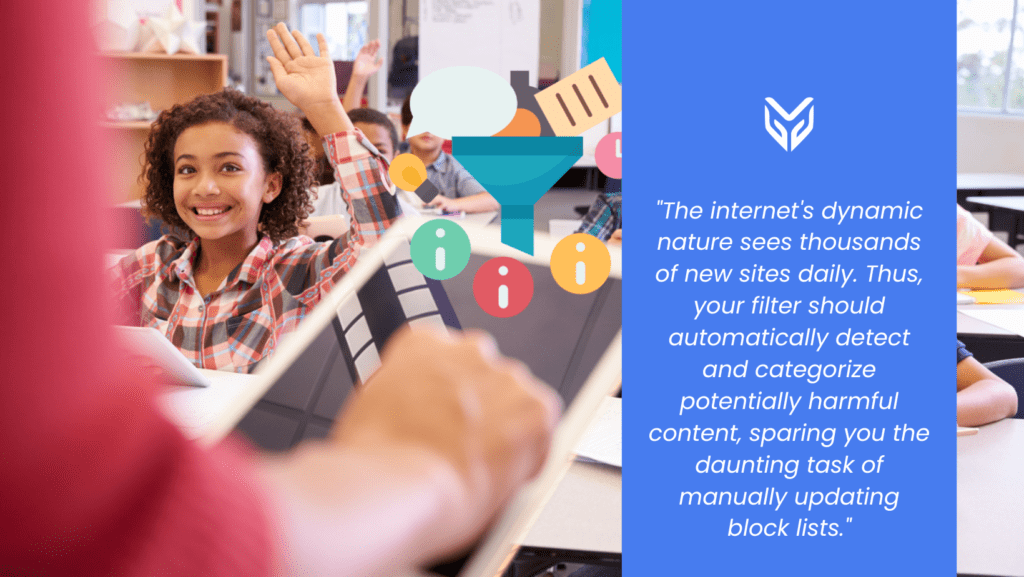NEWS
Choose Content Filtering of Highest Efficiency: Tips for IT Directors

Effective content filtering is fundamental for ensuring K-12 student safety, as exemplified by regulations such as the U.S. Children’s Internet Protection Act (CIPA) and similar guidelines in various countries worldwide. Given the imperative for educational institutions to adhere to web filtering protocols, your school most probably already has a web filter for compliance. However, merely fulfilling regulatory checkboxes falls short of ensuring optimal student protection. Simply implementing a filter doesn’t necessarily guarantee its effectiveness; as a school, you must choose content filtering of the highest efficiency to safeguard your students effectively.
#1 Was Your Web Filter Specifically Tailored for K-12 Educational Settings?
First and foremost, opt for a filter purpose-built for educational institutions. Such solutions streamline tasks and address the unique demands of K-12 environments, saving time and effort for IT professionals.

While many content filtering solutions cater to a broad range of industries, opting for a solution specifically designed for K-12 schools offers distinct advantages. These specialized filters are tailored to address educational environments’ unique challenges and requirements, such as age-appropriate content filtering, compliance with student privacy regulations, and integration with educational platforms and tools commonly used in schools.
#2 Is Your School Web Filtering Comprehensive Across Device Types?
With the proliferation of technology in education, ranging from laptops to tablets and smartphones, it’s imperative that your chosen content filtering solution seamlessly integrates with all device types commonly used in your educational institution. The ability to adapt to different operating systems and browsers ensures comprehensive coverage, regardless of the device students or staff are using.
When evaluating content filtering options, inquire about their support for Bring Your Own Device (BYOD) policies and guest networks. A robust filtering system should be flexible enough to cater to these scenarios without compromising security or ease of management. Additionally, consider how well the filter aligns with your authentication requirements.
To cater to the needs of any modern K-12 school, Blocksi cloud filtering offers multi-OS usage and also covers BYOD policies. Being cloud-based, our content filtering offers scalability, flexibility, and cost savings. Cloud-based storage is also more secure and easier to set up because tools like Blocksi require only a fast installation of an extension. And what’s more – there’s always the possibility of adding more devices without worrying the software won’t support it.
#3 Does Your School Web Filtering Categorize New Websites Automatically?
The internet’s dynamic nature sees thousands of new sites daily. Thus, your filter should automatically detect and categorize potentially harmful content, sparing you the daunting task of manually updating block lists.

With new websites popping up every day, relying solely on static block lists is no longer sufficient. Your chosen content filtering solution should employ advanced algorithms to automatically scan and categorize new websites in real-time. By leveraging machine learning and artificial intelligence technologies, modern filters can identify and mitigate emerging threats without manual intervention, ensuring proactive protection for students and staff alike.
Choose content filtering that will enable students to learn safely but without unnecessary boundaries; these are some signs your current filtering may be too restrictive.
While the policies remain flexible to customize, Blocksi AI-powered content filtering categorizes websites on the fly, without the need for a static database. Additionally, the filtering also blurs adult images and videos.
#4 Does Your K-12 Web Filtering Provide Customizable Policies for Various Users at Various Times?
That being said, tailoring filtering policies to specific user groups and scenarios is crucial. Flexibility in creating and managing policies saves time and ensures appropriate access for students and staff.
Every educational institution has unique requirements and student groups with varying needs. A one-size-fits-all approach to content filtering is inherently limiting and may not adequately address the diverse online activities conducted within your school environment. Look for a solution that offers granular control over filtering policies, allowing you to customize access levels based on student groups, ages, classes, specific times of the day, etc.
These are 5 ways how using an efficient school web filter saves educators precious time.
#5 Is Your K-12 Web Filtering Backed by a Student Well-being Monitoring Software?
Beyond safety, prioritize student well-being. Integration with student well-being monitoring software provides insights into students’ online activities, facilitating early intervention for mental health concerns.

By correlating online activities with indicators of emotional distress or behavioral changes, such as prolonged periods of online isolation or visits to concerning websites, educators and support staff can intervene promptly and provide appropriate assistance.
That is why Blocksi also covers K-12 threat detection, covering the whole Google Workspace environment and Outlook to check all potential threats, offering double protection backed by both AI and an expert human team. Each alert is reviewed pre- and post-trigger and, when confirmed, immediately forwarded to schools, parents, and relevant authorities.
Choose Content Filtering With Your Students’ and Staff’s Best Interests in Mind
If your current filter is falling short of operational efficiency and prioritizing student safety, it is time to explore alternatives and choose content filtering fit for your school. Reach out to us and let us assure you how Blocksi Cloud Filtering enhances online safety and supports student well-being, offering you and your staff complete support and control over students’ online activities.
Backed by both classroom screen monitoring and K-12 threat detection, we can help you customize our AI-powered cloud filtering to your institution’s individual needs today.
SOURCES
[1] Web Filtering for Schools: A Comprehensive Guide
[2] Top 27 Website Statistics For 2024 (Facts, Data & Traffic)





